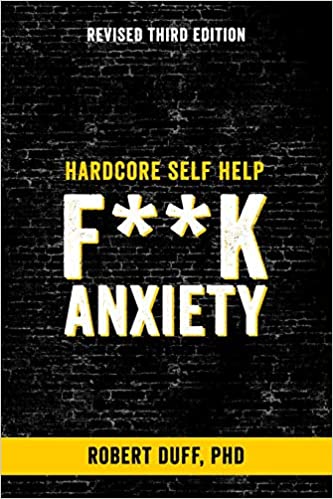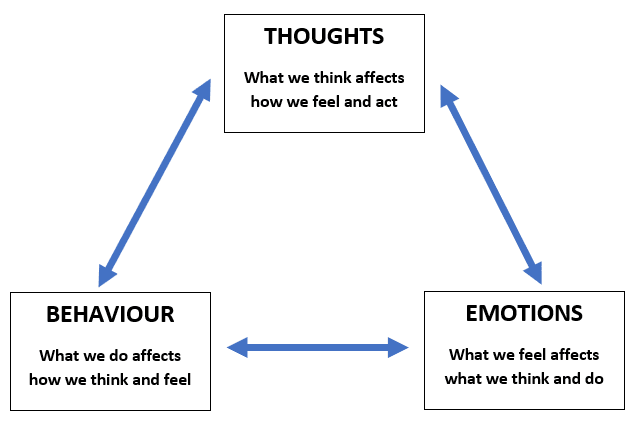Our Approach to Health and Rehabilitation
Ways to Deal with Anxiety for Teens
By C. Angelika Baum, CHt
Belief Change Coach & Workshop Facilitator
August 2020
One of my teenage clients is currently reading a book with the attention seeking title “F**k Anxiety” by clinical Psychologist Robert Duff, PHD, who claims to talk like “a normal person”, using swear words and youth jargon. I do not particularly care how important information is delivered if it successfully gets through to people and, of course, if it is not too simplified and still accurate. Curious whether the latter would be the case, I embarked on reading this relatively short book. Admittedly, the length might be a first advantage, when a parent wants their teen to read this book, or when somebody who would not normally pick up self-health literature comes across this volume.

Robert, as he wants to be called, embarks right away into swearing and trying to chum up to the younger generation by using phrases like “your brain is a huge douche” and promises “putting that asshole anxiety in its place”. He announces that he will use metaphors that will make you think “wtf is this guy smoking?” and does not fall short on this promise.
However, once you get past this trendy youth slang and mostly unnecessary use of profanities, the information that he provides is easy to digest, useful and applicable. His simple metaphors illustrate surprisingly well how anxiety affects us and how we can best work with anxiety. Because his examples are unusual, they guarantee that the newly learned material is retained.
In chapter one, called “WTF is Anxiety Anyway?”, the author briefly explains the evolutionary function of anxiety, how our sympathetic nervous system is activated and how the fight or flight response kicks in.
In chapter two, he addresses the CBT (Cognitive Behavior Therapy) approach of dealing with anxiety, explaining the cognitive triangle between thoughts, feelings and behavior. Our thoughts, feelings, and behaviours all affect each other. For example, our thoughts lead to feelings, which then affect our actions. As a belief change coach, I have to add that our subconscious beliefs direct all our conscious thoughts. Therefore, the most successful approach, in my opinion, is to change the subconscious belief programs which we hold in our subconscious mind and which automatically affect our thoughts.

Nevertheless, Duff explains and illustrates the connections between thought, emotions and behaviours well. He mentions the CBT strategy of keeping an ABC log. Under the rubric A, the “Activating Event” is recorded (what happened?) under C, the “Emotional Consequence” (how did I feel?) and under B, the “Belief” (what do I believe to be true about this situation?). He is very honest with his readers that with this approach a lot of repetition is required to change our beliefs and by extension, our anxious reaction. It is necessary to regularly and consistently apply this tool over a long period of time before seeing results. Working at a subconscious level and changing limiting beliefs into more supportive ones with techniques like PSYCH-K® is, in my personal experience, more efficient and effective.
In this second chapter, Duff also explains how thoughts sabotage us and gives entertaining examples for the following psychological responses:
- Filtering (magnifying negative details over positive)
- Overgeneralizations
- Polarized thinking(black or white thinking)
- Catastrophizing
- “Musturbation”(beating ourselves up with what we should be doing or must do)
- Mind reading(assumptions about others)
- Fortune telling(assumptions about what is going to happen)
- Personalizing(attributing personal meanings when things don’t have anything to do with us)
In chapter three, named “Your Body is an Asshole, Too”, Duff addresses the physical symptoms of anxiety and panic attacks, and what we usually forget when anxiety or panic take over. He says without sugar coating it, “it feels like you are going to die, but you will not. People don’t die from panic attacks”.
He introduces the very helpful coping mechanism of deep breathing, because deep breathing and anxious thoughts are incompatible. Duff describes the 4-7-8 breathing pattern. Breath in for 4 counts, hold for 7, and exhale for 8. He clarifies that deep breathing is not necessarily stopping the entire anxiety, rather it is like sprinkling water on a fire. He also emphasizes the necessity to practice deep breathing during non-anxious times. “Say you wanted to learn how to shoot a bow and arrow in order to hunt your food. Well, the first time you decide to go out and practice, it probably shouldn’t be when a lion is chasing you down. You will likely shoot wildly and miss your target.” Instead practicing shooting before going on the lion hunt is just as advisable as practicing deep breathing before the next anxiety attack happens.
However, the author is realistic when it comes to the effect of coping strategies like breathing. He states, “you just want to have some degree of influence over your anxiety so that you can give yourself a little more space to call the shots rather than just letting anxiety run the show” and “even if deep breathing only brings you from an 8/10 down to a 6/10, that might mean the difference between avoiding something and pushing through. That is powerful.”
Duff also mentions guided meditations as another resource to learn to relax. For guided meditations, please click here and go to my free meditations.
Chapter four has the title “Don’t Be a Jerk to Yourself” and addresses a topic which I often work on with my clients—our negative inner self talks—or as Duff phrases it, the “asshole language” that we use with ourselves. Our inner critic can be a friend or a foe and has a huge effect on our well-being and anxiety level.
Duff also reinforces taking breaks and doing nice things for ourselves instead of feeling guilty. Loving self-care gives us clarity and strength. He speaks about using positive mantras. As a belief change coach, my approach is to rather change the limiting subconscious belief than just use affirmations or mantras. However, the latter can be quite useful. Duff also mentions healthy food, plenty of water and enough sleep as important steps for self-care.
In the next chapter, the author addresses the negative and positive sides of technology when it comes to anxiety. Technology really is a “frenemy”. That we are accessible 24/7 is a double-edged sword. For some people, their e-mail (or other ways of communicating) have taken over their lives, and strategies like only checking our messages twice a day might need to be put in place. Social media, even though it provides ways to stay in touch or further our careers, also can trigger anxiety. How often have I heard clients share experiences of feeling excluded from events posted by others on social media, feeling pressure to keep up with others privately and professionally, or navigating the end of a relationship when everybody’s private life is out in the open via our social networks. Duff also reminds us that technology gives us access to apps for breathing and mediation or that it can be used to remind us of taking much-needed breaks.
I am very glad that in chapter six the author puts his original remarks of “slaying anxiety” or “kicking it in the balls” into perspective. Anxiety sufferers need to know that they won’t be able to make anxiety completely disappear from their life and that any effort put towards fully getting rid of the monster called anxiety is only going to backfire. However, we can learn how to better tolerate anxiety symptoms, and, I would like to add, live a full life and grow from having this challenge. Anxiety is not our enemy. We can treat it with mindfulness and like an overprotective friend who is unnecessarily worried for us and is not helping very effectively. To find out more about this concept, please read my blog “Hello, Old Pal Anxiety”. I have created a meditation specifically for anxiety.
Welcoming anxiety as a friend does not mean avoiding all situations which trigger anxiety. It simply means stopping to fight it and working with it. As Duff mentions, avoidance increase anxiety. On the other hand, gentle step by step exposure to the things that cause anxiety can give us our power back.
In chapter seven, Duff summarizes different anxiety disorders like GAD (generalized anxiety disorder), PD (panic disorder), phobias, PTSD (post traumatic stress disorder) and OCD (obsessive compulsive disorder). What is generally referred to in our everyday language as “OCD” when commenting on people who tend to be very specific about how they want or need things, e.g. excessively neat and clean or attached to certain routines, is at most OCPD (an obsessive compulsive personality disorder) but not a true OCD. Any of these disorders require a proper diagnosis.
Chapter eight is an excellent bonus chapter giving suggestions on how to explain to other people what life is like for the anxious person.
It is challenging to explain to somebody how anxiety feels physically or what it is like to have a whirlwind of thoughts and worries inside of your brain. Duff suggests comparing the thoughts to a song stuck in your head or to imagine multiplying the feelings we all have in certain situations (like exams, giving speeches, important days like weddings etc.) to understand what anxiety is like for an affected person.
When an anxiety attack takes over, it is hard to express what we need. However, one simple question the anxious person can usually still answer is, “Do you want me to give you some space?” The author even wrote a “letter” (printable off his website) that the reader can read out to an uncompassionate family member or friend to enlighten them a bit. Beyond this downloadable letter, Duff offers different online resources throughout his book, most of them via his podcast “The Hardcore Self Help Podcast”.
Overall, I would recommend this book for young readers. Other than the tough talk of slaying the dragon and being a “badass anxiety warrior”, I don’t disagree with the essential points the author makes or the advice he gives. The important point is to act and do something about the painful anxiety you are experiencing. Do your own work and apply the anxiety reducing techniques Duff mentions or reach out to a Psychotherapist or Coach to work with them.
Before booking a session, you will get the opportunity to have a free 20-minute phone consultation. You can ask all your questions and we can determine if we are a good fit as coach and client.
You can contact Awakening Health for more information on either couple’s coaching or individual sessions. We can work on your own triggers and patterns in individual sessions or on your interactions with each other.
Angelika
905-335-0372
This email address is being protected from spambots. You need JavaScript enabled to view it.
Learn More:
- Structure and Function
- The Mind Body Connection
- Managing Stress
- The Body as a Self Healing Mechanism
- The Concept of Compensations
- The Trouble with Core Stability
- What is scar tissue?
- Importance of Regular Maintenance
- Understanding Inflammation
- Inflammation and the Digestive System
- Plantar Fasciitis
- Sciatica
- What the Blue Jays Should Learn from Josh Donaldson's Injury
- Understanding Hypertension
- Myofascial Unwinding
- Detox
- Myofascial Release
- Acupuncture
- Is Marcus Stroman Healthy?
- Water
- The Placebo Effect
- Jays Matt Shoemaker Tears ACL
- To Stretch or Not To Stretch
- Prostate Health
- Changing Subconscious Beliefs
- How Does Muscle Testing Work Online
- Paul Married Alice: Is There A Perfect Match?
- Ways to Deal with Anxiety for Teens
- What is a woman’s most crucial role in her partner’s life?
- A Cold – Your Body Speaks Your Mind
CONTACT
-
Phone:905-335-0372
-
E-Mail:This email address is being protected from spambots. You need JavaScript enabled to view it.
-
Address:3-4300 Upper Middle Rd.
Burlington, ON L7M4P6

